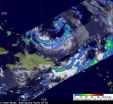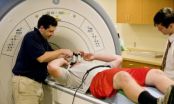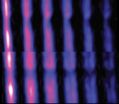(Press-News.org) NASA satellites have collected data as the Atlantic Ocean's Tropical Depression 17 has undergone two changes in less than 24 hours. Since Oct. 6, the depression has strengthened and has tropical storm-force winds and has morphed from a sub-tropical storm into a tropical storm.
After a United States Air Force Reserve reconnaissance flight subtropical depression seventeen was upgraded by the National Hurricane Center (NHC) to subtropical storm Otto on Oct. 6 at 5 p.m. EDT (2100 UTC). On Oct. 6 and 7, NASA's TRMM and Aqua satellites were flying overhead measuring very cold, high thunderstorm cloud tops and heavy rainfall.
The Tropical Rainfall Measuring Mission (TRMM) satellite is managed by NASA and the Japanese Space Agency. At NASA's Goddard Space Flight Center in Greenbelt, Md., meteorologists create satellite imagery from TRMM data. When TRMM passed above Otto this morning, Oct. 7 at 0945 UTC (5:45 a.m. EDT) the TRMM Precipitation Radar data revealed a feeder band in the southern part of the storm was dropping moderate to heavy rainfall (falling at a rate as much as 2 inches per hour). Coverage from TRMM Microwave Imager data indicated that convection in the center of the storm was generating thunderstorms.
At 11 a.m. EDT on Oct. 7, Tropical Storm Otto had maximum sustained winds near 60 mph, and strengthening is likely, according to the National Hurricane Center. Otto could become a hurricane in the next day or two. Otto was located about 255 miles northeast of Grand Turk Island or 620 miles south-southwest of Bermuda near 23.8 North latitude and 68.0 West longitude. Otto is far away enough from any land areas that there are no watches or warnings in effect. Otto was slowly trudging through the Atlantic Ocean at 2 mph and moving northeast. Otto's minimum central pressure was 992 millibars.
Forecasters at the NHC said that "Otto has finally transitioned into a tropical cyclone based on an analysis of vertical temperatures on Oct. 7 at 0935 UTC (5:35 a.m. EDT)" from the University of Wisconsin-Cooperative Institute for Meteorological Satellite Services (CIMSS). CMISS analyzed data from the Advanced Microwave Sounding Unit (AMSU) instrument. AMSU is a multi-channel microwave radiometer installed on a number of satellites, including NASA's Aqua satellite and NOAA polar orbiting satellites. The AMSU instrument examines several bands of microwave radiation from the atmosphere to provide data on temperature and moisture levels throughout a tropical cyclone. CIMSS utilizes NASA satellite data and offers real-time and archived tropical cyclone products from it home (web) page. The AMSU data indicated that the warm core of Otto had "moved upward" from the mid-levels of the storm to the upper-levels, re-classifying the storm as "tropical" instead of "sub-tropical."
Data from NASA's Atmospheric Infrared Sounder (AIRS) instrument also helped confirm the transition into a tropical storm. AIRS is an instrument that also flies aboard NASA's Aqua satellite. AIRS imagery showed a recent burst of deep convection, where the cloud top temperatures were near -80 Celsius (-112 Fahrenheit) over the center of Otto.
Microwave images are created when data from NASA's Aqua satellite AIRS and AMSU instruments are combined. A microwave image from data at 2:29 a.m. EDT on October 7 was created at NASA's Jet Propulsion Laboratory, Pasadena, Calif. The image indicated there was a large area of precipitation or ice in the cloud tops in Tropical Storm Otto.
Otto is meandering around, but a large trough (an elongated area of low pressure) that is along the U.S. East Coast is expected to continue moving east and push Otto into the open waters of the Atlantic over the next couple of days.
INFORMATION:
NASA satellites see Otto become a tropical storm
2010-10-08
ELSE PRESS RELEASES FROM THIS DATE:
Saturn's icy moon may keep oceans liquid with wobble
2010-10-08
Saturn's icy moon Enceladus should not be one of the most promising places in our solar system to look for extraterrestrial life. Instead, it should have frozen solid billions of years ago. Located in the frigid outer solar system, it's too far from the sun to have oceans of liquid water -- a necessary ingredient for known forms of life -- on its surface.
Some worlds, like Mars or Jupiter's moon Europa, give hints that they might harbor liquid water beneath their surfaces. Mars is about 4,200 miles across and Europa almost 2,000 miles across. However, with a diameter ...
3-way control of fetal heart-cell proliferation could help regenerate cardiac cells
2010-10-08
PHILADELPHIA - Heart muscle cells do not normally replicate in adult tissue, but multiply with abandoned during development. This is why the loss of heart muscle after a heart attack is so dire—you can't grow enough new heart muscle to make up for the loss.
A team of researchers at the University of Pennsylvania School of Medicine describe the interconnections between three-molecules that control fetal, heart-muscle-cell proliferation in a mouse model that will help cardiologists better understand the natural repair process after heart attacks and help scientists learn ...
Can you analyze me now? Cell phones bring spectroscopy to the classroom
2010-10-08
CHAMPAIGN, Ill. — University of Illinois chemistry professor Alexander Scheeline wants to see high school students using their cell phones in class. Not for texting or surfing the Web, but as an analytical chemistry instrument.
Scheeline developed a method using a few basic, inexpensive supplies and a digital camera to build a spectrometer, an important basic chemistry instrument. Spectrophotometry is one of the most widely used means for identifying and quantifying materials in both physical and biological sciences.
"If we want to measure the amount of protein in ...
Technique allows researchers to examine how materials bond at the atomic level
2010-10-08
An approach pioneered by researchers at North Carolina State University gives scientists new insight into the way silicon bonds with other materials at the atomic level. This technique could lead to improved understanding of and control over bond formation at the atomic level, and opportunities for the creation of new devices and more efficient microchips.
Manufacturers build silicon-based devices from layers of different materials. Bonds – the chemical interaction between adjacent atoms – are what give materials their distinctive characteristics. "Essentially, a bond ...
Scientists trick bacteria with small molecules
2010-10-08
New Haven, Conn.—A team of Yale University scientists has engineered the cell wall of the Staphylococcus aureus bacteria, tricking it into incorporating foreign small molecules and embedding them within the cell wall.
The finding, described online in the journal ACS Chemical Biology this week, represents the first time scientists have engineered the cell wall of a pathogenic "Gram-positive" bacteria—organisms responsible not only for Staph infections but also pneumonia, strep throat and many others. The discovery could pave the way for new methods of combating the bacteria ...
Brain changes found in football players thought to be concussion-free
2010-10-08
WEST LAFAYETTE, Ind. - A study by researchers at Purdue University suggests that some high school football players suffer undiagnosed changes in brain function and continue playing even though they are impaired.
"Our key finding is a previously undiscovered category of cognitive impairment," said Thomas Talavage, an expert in functional neuroimaging who is an associate professor of biomedical engineering and electrical and computer engineering and co-director of the Purdue MRI Facility.
The findings represent a dilemma because they suggest athletes may suffer a form ...
Author who revealed unethical Guatemala syphilis study writes for Bioethics Forum
2010-10-08
(Garrison, NY) The researcher whose revelations about unethical U.S. studies on syphilis in Guatemala in the 1940's led to apologies from the Obama administration last week has written a commentary for Bioethics Forum, the Hastings Center's online publication. She calls for the need to learn from history to better protect human subjects in the developing world.
Susan M. Reverby, a professor at Wellesley College, describes how she unearthed documents about the study by accident while doing research for a book on the Tuskegee syphilis study. The documents, hidden in the ...
Notre Dame researcher helps discover 'walking' properties of bacteria
2010-10-08
Talk about a walk on the wild side: University of Notre Dame researcher Joshua Shrout is co-author of a new paper that shows that bacteria are capable of "standing up" and moving while vertical.
Shrout, assistant professor of civil engineering and geological sciences and a member of the Eck Institute for Global Health, has been studying the surface motility of bacteria since 2004. In 2008, UCLA researcher Gerard Wong suggested that an undergraduate bioengineering senior design group that he was advising track the bacterium Shrout was studying. After some interesting patterns ...
MRI zooms in on microscopic flow
2010-10-08
"Better and faster results!" is the clarion call for scientists and engineers to continually strive to improve their research tools. Of the tools used to study material structures at the atomic and molecular scales, there is none finer than Nuclear Magnetic Resonance (NMR) spectroscopy and its daughter technology Magnetic Resonance Imaging (MRI). Now, the latest development from the research group of one of the word's foremost authorities on NMR/MRI technology promises NMR/MRI results that are better and faster than ever before – a million times faster!
Through a combination ...
In Parkinson's disease, brain cells abandon mitochondria, researchers report
2010-10-08
In a study that sheds new light on the causes of Parkinson's disease, researchers report that brain cells in Parkinson's patients abandon their energy-producing machinery, the mitochondria. A shutdown in fuel can have devastating effects on brain cells, which consume roughly 20 percent of the body's energy despite making up only 2 percent of body weight.
The findings indicate that boosting the mitochondria with FDA approved drugs early on may prevent or delay the onset of Parkinson's. The study will be published in the one-year anniversary issue of the journal Science ...




